
Eriosyce bulbocalyx Photo by: Valentino Vallicelli
Origin and Habitat: Eriosyce bulbocalyxSN|1818]]SN|1818]] species is endemic to Argentina (La Rioja, San Juan, San Luis).
Altitude: It grows at elevations of 500 to 1500(-2400) metres above sea level.
Habitat and Ecology: The species grows in monte shrubland and chaco forest, in rocky shallow soils along with Setiechinopsis mirabilisSN|3878]]SN|3878]]. There are no known major threats for the species, it has a wide range, is relatively abundant, and occurs in protected areas.
Synonyms:
See all synonyms of Eriosyce bulbocalyx
Description: Eriosyce bulbocalyxSN|1818]]SN|1818]] is a solitary globular cactus with unique and remarkably beautiful shape. The apex is characteristically covered with very thick, incurved, rust-coloured spines.
Stem: Globose to sub-globose or short-cylindrical as it becomes old, grey green, up to 12 cm in diameter, eventually up to 50 cm tall.
Ribs: 12-13(-17), swollen beneath the areoles.
Areoles: Conspicuous, oval, woolly and hairy when young (with yellowish felt), later naked.
Central spines: 1-4, subulate, nearly 2,5 cm long, stout, typically rusty red or horn coloured, but ranging from pale-yellow to dark-brown, becoming grey as the age, sometime with black tips, all curved upwards, base swollen.
Radial spines: 7 to 12 about 1,5-2 cm long, similar to the centrals or paler.
Flowers: Subapical, from the centre of the plant, urn-shaped, 2,5-5 cm in diameter, straw coloured, yellow or green yellow with red throat. Scales with dense wool and several bristles.
Fruit: Small, almost spherical, dry, green often disintegrating at maturity.
Seeds: Dull black.
Chromosome number: 2n = 22.
Remarks: Specimens from natural habitats generally have a thicker spination and a thicker epidermal layer.
Subspecies, varieties, forms and cultivars of plants belonging to the Eriosyce bulbocalyx group
Bibliography: Major references and further lectures
1) Edward Anderson “The Cactus family” Timber Press, Incorporated, 2001
2) Nathaniel Lord Britton, Joseph Nelson Rose “Cactaceae: Descriptions and Illustrations of Plants of the Cactus Family” vol. 4 The Carnegie Institution of Washington, Washington 1923
3) James Cullen, Sabina G. Knees, H. Suzanne Cubey "The European Garden Flora Flowering Plants: A Manual for the Identification of Plants Cultivated in Europe, Both Out-of-Doors and Under Glass" Cambridge University Press, 11/Aug/2011
4) David R Hunt; Nigel P Taylor; Graham Charles; International Cactaceae Systematics Group. "The New Cactus Lexicon" dh books, 2006
5) Fred Kattermann "Eriosyce (Cactaceae): The Genus Revised and Amplified" David Hunt, 1994
6) Trevisson, M., Perea, M. & Demaio, P. 2013. Eriosyce bulbocalyx. In: IUCN 2013. "IUCN Red List of Threatened Species." Version 2013.2. <www.iucnredlist.org>. Downloaded on 15 February 2014.
7) Hans Hecht “BLV-Handbuch der Kakteen” BLV-Verlagsgesellschaft, 1982
8) E Haustein “Der Kosmos Kakteenfuehrer (the Kosmos Cactus Guide)” Balogh Scientific Books 01 December 1998
9) J.G. Lambert Ir. A.I.Gx. “Cactus d’Argentine” 2ème édition Revue et complétée, Concordia-Roeselare., 1997
 Eriosyce bulbocalyx Photo by: Carolina González
Eriosyce bulbocalyx Photo by: Carolina González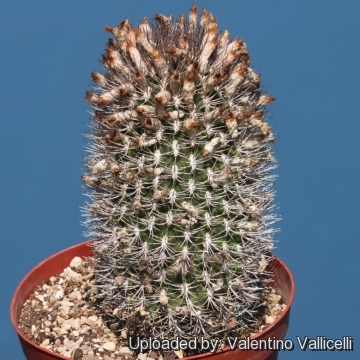 Eriosyce bulbocalyx Photo by: Valentino Vallicelli
Eriosyce bulbocalyx Photo by: Valentino Vallicelli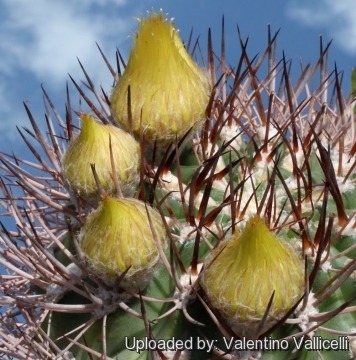 Eriosyce bulbocalyx Photo by: Valentino Vallicelli
Eriosyce bulbocalyx Photo by: Valentino Vallicelli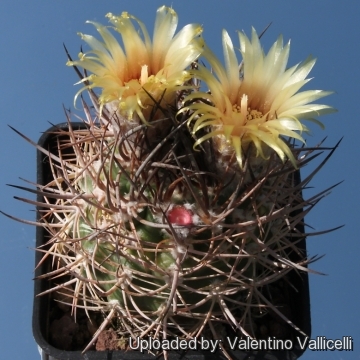 Eriosyce bulbocalyx Photo by: Valentino Vallicelli
Eriosyce bulbocalyx Photo by: Valentino Vallicelli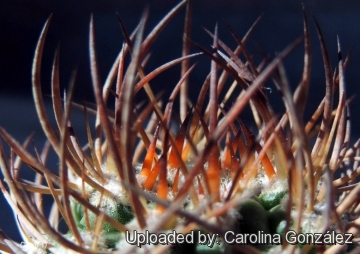 Eriosyce bulbocalyx Photo by: Carolina González
Eriosyce bulbocalyx Photo by: Carolina González Eriosyce bulbocalyx Photo by: Valentino Vallicelli
Eriosyce bulbocalyx Photo by: Valentino Vallicelli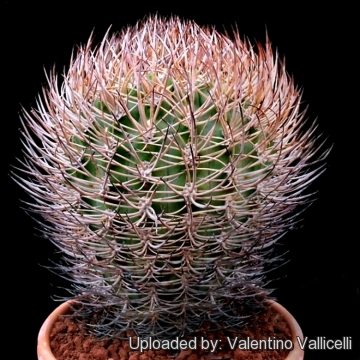 A mature specimen h 15 cm, diameter 11 cm Photo by: Valentino Vallicelli
A mature specimen h 15 cm, diameter 11 cm Photo by: Valentino Vallicelli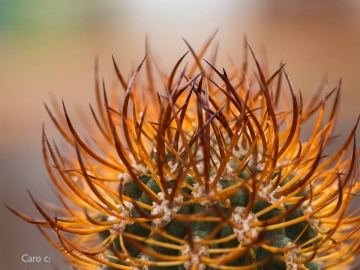 Eriosyce bulbocalyx Photo by: Carolina González
Eriosyce bulbocalyx Photo by: Carolina GonzálezCultivation and Propagation: It is a summer-growing species of relatively easy cultivation that continues to be, a particular prize among collectors. This plant is extremely xerophytic, adapted to very dry soils and is quite susceptible to over-watering if kept in a non ventilated place.
Growth rate: Slow-growing.
Soil: Grow it in an open mineral, sandy-gritty cactus compost and provide a very good drainage.
Exposure: It is suited for sunny-brightly exposure, but can tolerate light shade. However it will do its best only with lots of sun and become stressed with inadequate light which could result in poor growth and unnatural shape. It has a good heat tolerance.
Watering: Water sparingly and keep it completely dry during winter. Mature individuals easily rot and die especially after transplanting so be extremely cautious with watering. Keep dry in winter or when night temperatures remain below 10° C. Water it less than average if in bigger pots.
Fertilization: Feed them once during the growing season with a fertilizer specifically formulated for cactus and succulents (high potash fertilizer with a dilute low nitrogen), including all micro nutrients and trace elements diluted to ½ the strength recommended on the label. They thrive in poor soils and need a limited supplies of fertilizer to avoid the plants developing excess vegetation, which is easily attacked by fungal diseases.
Special need: It is suited for airy exposures. Provide very good ventilation. Nearly all problems occur as a result of overwatering and poor ventilation, especially when weather conditions are dull and cool or very humid. They must have very dry atmosphere.
Hardiness: It likes warmth (recommended minimum winter temperature 5° C) But plants kept perfectly dry can easily survive to winter night temperatures below 0° C.
Pests & diseases: These cacti may be attractive to a variety of insects, but plants in good condition should be nearly pest-free, particularly if they are grown in a mineral potting-mix, with good exposure and ventilation. Nonetheless, there are several pests to watch for:
- Red spiders: Red spiders may be effectively rubbed up by misting the plants from above.
- Mealy bugs: Mealy bugs occasionally develop aerial into the new leaves and flowers with disfiguring results, but the worst types develop underground on the roots and are invisible except by their effects.
- Scales, thrips and aphids: These insects are rarely a problem.
- Rot: Rot is only a minor problem if the plants are watered and “aired” correctly. If they are not, fungicides won't help all that much.
Propagation: Usually propagated from seeds (seldom produces offsets) or graft. The seeds can be sown in pots of fine, well-drained sandy soil, any time during the spring when temperatures are warm. Cover the seeds with a fine layer of grit and water from below with a fungicide to prevent damping off. For the 1-2 weeks cover the pots with a sheet of glass/clear perspex to keep the humidity levels high. Remove the glass and replace it with light shade-cloth and mist once or twice a day for the next two weeks after which most seeds should have germinated. From then on mistings can be reduced to every second and then every third day as the little plants grow. The seedlings should not be disturbed until they are well rooted after which they can be planted separately in small pots. Sometimes it is grafted to avoid root rot problems as plants grafted on an hardy stock are easy to grow and no special skill is required.
Your Photos

by Cactus Art

by Valentino Vallicelli

by Valentino Vallicelli

by Cactus Art
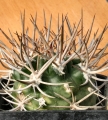
by Valentino Vallicelli
























